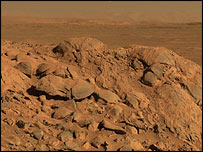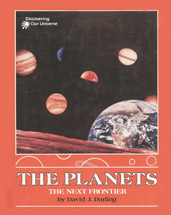PLANETS: 1. The Kingdom of the Sun

Jupiter and one of its moons.
As you read this, several robot spacecraft are circling the planet Mars or trundling across its desert-like surface. Another space probe is going around giant Saturn, taking pictures of its many rings and moons. Yet another spacecraft from Earth is on its way to the innermost planet, Mercury.
 |
| The surface of Mars
|
Since 1962, several dozen robot explorers have journeyed to the planets Mercury, Venus, Mars, Jupiter, Saturn, Uranus, and Neptune. Only Pluto remains unvisited. Spacecraft have studied asteroids and comets at close range. Four are even heading out on long, lonely voyages to the stars. These planetary probes have begun what promises to be a thrilling adventure – the exploration of the Sun's kingdom, the Solar System.
What Makes Up the Solar System?
Of all the things within its kingdom, the Sun itself is the most important. It is a yellow star, 865,000 miles (1,392,000 kilometers) in diameter. The Sun weighs 500 times more than the rest of the Solar System put together. Everything else orbits, or moves around the Sun, trapped by its strong pull of gravity.
After the Sun, the next most important objects in the Solar System are the planets. There are nine of these, circling the Sun at different distances. Mercury, the closest planet, is just 36 million miles (58 million kilometers) away. Pluto, the farthest, is 3.6 billion miles (5.9 billion kilometers) away, 100 times as far as Mercury. We live on the third planet out from the Sun, at a distance of 93 million miles (150 million kilometers).
If we could somehow shrink the Solar System down so that the Sun were the size of a basketball, then Mercury would be the size of a pinhead 11 yards away from it. Earth would be the size of this O, 28 yards away. Jupiter, the largest planet, would be the size of a ping-pong ball almost 150 yards away. Pluto, the smallest and most distant planet, would be the size of the period at the end of this sentence nearly 2 miles away.
By now you may think the Solar System is a very big place. It's true that even our fastest spacecraft take quite a few years to reach the outer planets. But the Sun's kingdom is a tiny speck in space. Even the nearest star to the Sun, on the same scale as our model, would be 4,300 miles (6,919 kilometers) away!
Orbiting most of the planets are smaller objects called satellites or moons. Earth has just one satellite, the Moon. Jupiter and Saturn, on the other hand, have many satellites – some large, some small (see Figure 1).
Along with the Sun and the planets and their moons, countless other objects orbit the Sun in different ways. There are asteroids – mountains of rock, most of which are found in a belt around the Sun between Mars and Jupiter. There are meteors – smaller pieces of rock and dust that fly everywhere through the Sun's kingdom, often in swarms. And there are comets – chunks of rock and ice that orbit the Sun in very long, oval paths.
How Can We Group the Planets?
The Solar System is filled with interesting objects. One planet spins on its side. Another planet has a mysterious red spot big enough to swallow the earth. The world closest to the Earth has a surface hotter than any oven and an atmosphere containing burning acid.
Even with all these differences, some planets have important things in common. The four planets closest to the Sun – Mercury, Venus, Earth, and Mars – are all "rocky" worlds. In other words, they have surfaces and insides made mainly of rock. They are also the warmest planets because they receive the most heat from the Sun.
Along with Pluto – an odd planet at the outpost of the Solar System – these two groups of planets make up the planetary system of the Sun. Each planet has something special that sets it apart from the others.

